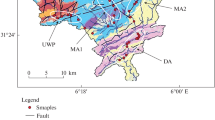Abstract
X-ray analyses of the clay minerals from thousands of sediments indicate that any of the major clay minerals can occur in abundance in any of the major depositional environments and there is no consistent coincidence between specific clay minerals and specific depositional environments. It is concluded that the great majority of clay minerals in sedimentary rocks are detrital in origin, strongly reflect the character of their source material, and are only slightly modified in their depositional environments.
The most common process acting on the clay minerals in marine environments is cation adsorption. The modifications produced by this process are secondary but because of the overemphasis of names rather than processes, they have been considered fundamental changes and the process has been called diagenesis. From the geologist’s viewpoint, the basic clay mineral lattice, which is inherited from the source material, is the most significant parameter of the clay minerals and modifications caused by the adsorbed cations are secondary, derived parameters reflecting the character of the depositional environment. This concept of dualism is essential to the understanding of clay genesis, and the significance of the two parameters must be understood before a genetic classification can be constructed and before clays can be used for geologic interpretation.
Similar content being viewed by others
References
Brown, George, 1953, The dioctahedral analogue of vermiculite: Clay Min. Bull., v. 2, p. 64–70.
Galliher, E. W., 1935, Geology of glauconite: Amer. Assoc. Petroleum Geologists Bull., v. 19, p. 1569–1601.
Gilluly, James, 1949, Distribution of mountain building in geologic time: Geol. Soc. Amer. Bull., v. 60, p. 561–590.
Grim, R. E., 1951, The depositional environment of red and green shales: J. Sed. Petrology, v. 21, p. 226–232.
Grim, R. E., 1953, Clay mineralogy: McGraw-Hill Book Company, Inc., New York., 384 p.
Hendricks, S. B., and Ross, C. S., 1941, Chemical composition and genesis of glauconite and celadonite: Am. Min., v. 26, p. 683–708.
Krynine, P. D., 1949, The origin of red beds: New York Acad. Sci. Trans., ser. 2, v. 2, p. 60–68.
Kunze, G. W., and Jeffries, C. D., 1953, X-ray characteristics of clay minerals as related to potassium fixation: Soil Sci. Soc. Amer. Proc., v. 17, p. 242–244.
Levinson, A. A., 1955, Studies in the mica group: Polymorphism among illites and hydrous micas: Am. Min., v. 40, p. 41–49.
Millot, Georges, 1949, Relations entre la constitution et la genèse des roches sédimentaires argileuses: Géol. Appliq. et Prosp. Min., v. 2, Nancy, France, 352 p.
Millot, Georges, 1953, Héritage et néoformation dans la sédimentation argileuse: Congrès Géologique International, 1952, Fascicule 18, 163–175.
Pettijohn, F. J., 1949, Sedimentary rocks: Harper & Brothers, New York, 526 p.
Powers, M. C., 1957, The adjustment of land derived clays to the marine environment: J. Sed. Petrology, v. 27, p. 355–372.
Rice, C. M., 1948, Dictionary of geological terms: Edwards Brothers, Inc., Ann Arbor, Michigan, 461 p.
Rich, C. L., and Obenshain, S. S., 1955, Chemical and clay mineral properties of a Red-Yellow Podzolic soil derived from muscovite schist: Soil Sci. Soc. Amer. Proc., v. 19, p. 334–339.
Rivière, André, 1953, Sur l’origine des argiles sédimentaires, Congrès Géologique International, 1952, Fascicule 18, p. 177–180.
Van der Marel, H. W., 1954, Potassium fixation in Dutch soils: Mineralogical analyses: Soil Sci., v. 78, p. 267–287.
Walker, G. F., 1949, The decomposition of biotite in the soil: Min. Mag., v. 28, p. 693–703.
Weaver, C. E., 1953, Mineralogy and petrology of some Ordovician K-bentonites and related limestones: Geol. Soc. Amer. Bull., v. 64, p. 921–943.
Yoder, H. S., and Eugster, H. P., 1955, Synthetic and natural muscovites: Geochimica et Cosmochimica Acta, v. 8, p. 225–280.
Author information
Authors and Affiliations
Rights and permissions
About this article
Cite this article
Weaver, C.E. A Discussion on the Origin of Clay Minerals in Sedimentary Rocks. Clays Clay Miner. 5, 159–173 (1956). https://doi.org/10.1346/CCMN.1956.0050113
Published:
Issue Date:
DOI: https://doi.org/10.1346/CCMN.1956.0050113




